21 Oct Questions for Remote Learning During and After the Pandemic
By Helen Kwah
K-12 schools in the U.S. and India have resumed during the Covid-19 pandemic following an all-remote or hybrid learning model with students spending more days in remote rather than in-person learning. However, when instruction is remote, students miss out on the cognitive and social benefits of face-to-face interaction with their teachers and peers.
One way schools are bringing in live interaction is by livestreaming classes but this is not a perfect substitute. Some issues are that livestreaming programs like Zoom make it hard for teachers and students to read the bodily and facial cues needed for communication and mutual understanding. Also, these programs make spontaneous conversations difficult unless students are arranged into smaller groups. When livestreaming is not possible, remote learning has meant curriculum delivered as instructional materials online or in hard copy form.
Clearly the pandemic has forced schools to adopt more remote learning than ideal but what is the ideal? What are models and best practices for remote learning to support all students – younger, older, with special needs or other differences? Is remote learning best as a supplement (i.e. tutoring), or for instruction with in-person time dedicated to practice and individual support (i.e. flipped classroom model)? Educators and parents have an opportunity right now to consider these questions and shift the conversation on how remote learning can serve the needs of diverse students. In future posts, we will explore some of these questions in more depth.


No Comments